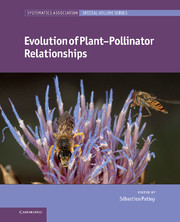Book contents
- Frontmatter
- Contents
- Contributors
- Preface
- 1 Macroevolution for plant reproductive biologists
- 2 Pollination crisis, plant sex systems, and predicting evolutionary trends in attractiveness
- 3 Evolution and ecological implications of “specialized” pollinator rewards
- 4 Fig–fig wasp mutualism: the fall of the strict cospeciation paradigm?
- 5 Fossil bees and their plant associates
- 6 Pollen evidence for the pollination biology of early flowering plants
- 7 Pollinator mediated floral divergence in the absence of pollinator shifts
- 8 Animal pollination and speciation in plants: general mechanisms and examples from the orchids
- 9 Why are floral signals complex? An outline of functional hypotheses
- 10 A survey on pollination modes in cacti and a potential key innovation
- 11 Zygomorphy, area, and the latitudinal biodiversity gradient in angiosperms
- 12 Ambophily and “super generalism” in Ceratonia siliqua (Fabaceae) pollination
- 13 Structure and dynamics of pollination networks: the past, present, and future
- 14 Pollinators as drivers of plant distribution and assemblage into communities
- 15 Effects of alien species on plant–pollinator interactions: how can native plants adapt to changing pollination regimes?
- 16 Pollen resources of non-Apis bees in southern Africa
- 17 Advances in the study of the evolution of plant–pollinator relationships
- Index
- Plate section
- References
4 - Fig–fig wasp mutualism: the fall of the strict cospeciation paradigm?
Published online by Cambridge University Press: 05 January 2012
- Frontmatter
- Contents
- Contributors
- Preface
- 1 Macroevolution for plant reproductive biologists
- 2 Pollination crisis, plant sex systems, and predicting evolutionary trends in attractiveness
- 3 Evolution and ecological implications of “specialized” pollinator rewards
- 4 Fig–fig wasp mutualism: the fall of the strict cospeciation paradigm?
- 5 Fossil bees and their plant associates
- 6 Pollen evidence for the pollination biology of early flowering plants
- 7 Pollinator mediated floral divergence in the absence of pollinator shifts
- 8 Animal pollination and speciation in plants: general mechanisms and examples from the orchids
- 9 Why are floral signals complex? An outline of functional hypotheses
- 10 A survey on pollination modes in cacti and a potential key innovation
- 11 Zygomorphy, area, and the latitudinal biodiversity gradient in angiosperms
- 12 Ambophily and “super generalism” in Ceratonia siliqua (Fabaceae) pollination
- 13 Structure and dynamics of pollination networks: the past, present, and future
- 14 Pollinators as drivers of plant distribution and assemblage into communities
- 15 Effects of alien species on plant–pollinator interactions: how can native plants adapt to changing pollination regimes?
- 16 Pollen resources of non-Apis bees in southern Africa
- 17 Advances in the study of the evolution of plant–pollinator relationships
- Index
- Plate section
- References
Summary
Introduction
At least three classic systems of nursery pollination mutualism are known: the fig (Ficus, Moraceae) – agaonid (Hymenoptera, Chalcidoidea) association (Cook and Rasplus 2003), the yucca (Yucca, Hesperoyucca; Agavaceae) – yucca moths (Tegeticula, Parategeticula; Lepidoptera, Prodoxidae) association (Pellmyr 2003) and the Glodichion (Phyllanthaceae) – Epicephala moths (Lepidoptera, Gracillariidae) association (Kato et al. 2003). All these mutualisms are obligate, which means that each partner depends on the other for its own reproductive success. The insect pollinates the flowers and oviposits in the plant ovaries where the insect larvae subsequently feed on a subset of the developing seeds. A shift from mutualism to parasitism by the pollinating insect would lead to reproduction failure of the plant and, without host shift, to the extinction of both lineages. Therefore, the speciation of mutualistic pollinators is generally believed to be driven by the speciation of their host-plants. In this hypothesis, when an ancestral plant species splits into two daughter species, its mutualistic pollinator also splits. This scenario should result in perfect congruence of hosts and pollinator phylogenies (Farenholz’s rule) (Farenholz 1913). However, this seems increasingly unlikely. Indeed, more and more studies on different coevolved associations show that a strict Farenholz’s rule is not respected, even when a high level of host specificity exists (e.g. Paterson and Banks 2001; Desdevises et al. 2002; Charleston and Perkins 2006).
Topological incongruence between host and associate phylogenetic trees can result from processes like host switching, sorting events (extinction and lineage sorting), duplication events (speciation of the parasite independent of the host), and failure of the associate to diverge when the host diverges (“missing the boat”) (Page 1991; Page 1994; Page and Charleston 1998; Legendre et al. 2002; Charleston and Perkins 2006).
- Type
- Chapter
- Information
- Evolution of Plant-Pollinator Relationships , pp. 68 - 102Publisher: Cambridge University PressPrint publication year: 2011
References
- 3
- Cited by



